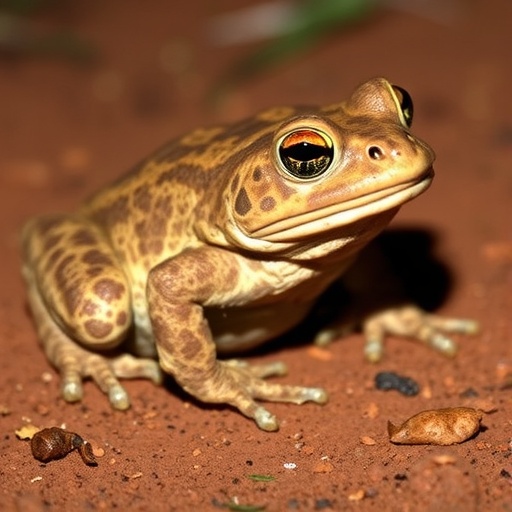Invasive Cane Toads Poised to Devastate Biodiversity in Australia’s Pilbara Region: Urgent Containment Measures Needed
A recent groundbreaking study from Curtin University has sounded the alarm on the impending ecological catastrophe posed by the spread of the invasive cane toad (Rhinella marina) into Western Australia’s Pilbara region. Known for their toxic defenses and rapid proliferation, cane toads threaten to upend the region’s fragile ecosystems, imperiling a diverse array of native species and generating profound cultural and economic repercussions. The research, appearing in the prestigious journal Scientific Reports, combines advanced data modeling and ecological analysis to forecast the extent and impact of this invasive amphibian’s expansion over the next few decades.
With their toxic secretions making them lethal to many native predators unfamiliar with the threat, cane toads have already wrought havoc across northern Australia’s Kimberley region. The study projects that without strategic containment efforts, these amphibians will colonize up to 75 percent of the Pilbara’s terrain within 30 years. This expansion jeopardizes at least 25 native species, including emblematic marsupial predators such as the northern quoll, as well as bats, reptiles, and other fauna intricately linked within the region’s ecological web. The impending loss threatens not only biological diversity but also the cultural heritage and subsistence practices of Indigenous communities.
Among the species predicted to face dire consequences are northern quolls, ghost bats, kalutas, frog-eating snakes, blue-tongue skinks, and goannas. Nine of these at-risk mammals and reptiles could be newly classified as threatened, while species already vulnerable, such as the ghost bat, face escalation to higher threat categories. This underscores the urgency of intervention to halt the toads’ advance before irreversible damage occurs. The toxic amphibians’ presence could trigger cascading ecosystem effects, destabilizing predator-prey dynamics and undermining conservation efforts for decades.
The study emphasizes that the Pilbara’s permanent water sources represent critical ecological corridors that facilitate cane toad dispersal. Lead author Dr. Judy Dunlop highlights that these water bodies, particularly dams constructed for cattle watering, serve as stepping stones enabling toads to traverse the otherwise arid landscape. “The toads’ ability to exploit artificial waterpoints is central to their southward expansion through the desert zones where natural water is scarce,” explained Dr. Dunlop. This insight reveals a tangible target for mitigation strategies—modifying water infrastructure to exclude toads could significantly hinder their progression.
A proposed “toad containment zone,” extending approximately 150 kilometers, could effectively restrict the amphibians’ access to human-made water sources. By upgrading cattle watering points—such as converting earthen dams to concrete tanks or troughs designed to be inaccessible to toads—land managers can establish a functional barrier analogous to the firebreaks used in wildfire management. This containment zone concept offers a scalable, cost-effective approach to slow or prevent the toads’ colonization of the Pilbara.
Professor Ben Phillips, co-author of the study and expert in molecular and life sciences at Curtin University, elaborated on the broader significance of containment efforts. “If we act swiftly, it is possible to push the invasion front back to the northern limits, preserving vital biodiversity and maintaining ecological balance,” he noted. The approach reinforces that invasive species management benefits greatly from integrating ecological knowledge with practical infrastructure modifications.
The ramifications of the cane toad invasion extend beyond ecological impacts to encompass profound cultural dimensions. Many of the affected species—including goannas and blue-tongue skinks—hold significant traditional value for the Pilbara’s Indigenous custodians, forming the foundation for cultural storytelling, subsistence, and bushtucker practices. The loss or decline of these species would thus represent a cultural blow alongside environmental degradation, underscoring the multidimensional nature of the issue.
Economically, Western Australia’s mining sector could face increased operational costs and regulatory compliance obligations if toad-induced biodiversity loss alters conservation statuses of local fauna. Tailored mitigation strategies could help minimize these costs, providing a strong incentive for collaboration between conservationists, Indigenous communities, and industrial stakeholders. The study underscores that proactive management is both an ecological necessity and an economic safeguard.
The scientific methodology underpinning this study involved rigorous data and statistical analyses, integrating species distribution models with ecological risk assessments. This modeling approach allowed the researchers to quantify potential biodiversity losses and identify critical control points within the landscape. The robustness of the data-derived predictions lends credibility to the proposed containment interventions and provides a framework for monitoring and adaptive management moving forward.
Support for the research was provided by BHP Social Investments, highlighting the importance of partnerships between academic institutions and industry leaders in tackling complex environmental challenges. Such collaborations are essential for translating academic insights into actionable conservation policies and infrastructure investments.
The full study, titled “Quantifying the potential impact of the cane toad (Rhinella marina) on biodiversity in Australia’s Pilbara region,” not only delivers a stark warning but also offers hope through practical, evidence-based solutions. As the cane toad invasion looms, this research advocates for immediate, coordinated action to safeguard Australia’s unique biodiversity, protect cultural heritage, and mitigate economic risks before it is too late.
Subject of Research: Animals
Article Title: Quantifying the potential impact of the cane toad (Rhinella marina) on biodiversity in Australia’s Pilbara region
News Publication Date: 10-Nov-2025
Web References: http://dx.doi.org/10.1038/s41598-025-24017-4
References: Quantifying the potential impact of the cane toad (Rhinella marina) on biodiversity in Australia’s Pilbara region, Scientific Reports (2025)
Image Credits: Dr Judy Dunlop
Keywords: Wildlife, Conservation biology




